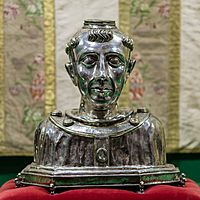Tysilio facts for kids
Quick facts for kids Saint Tysilio |
|
|---|---|

|
|
| Bishop | |
| Born | Late 6th century Powys, Wales |
| Died | 640 what is now Saint-Suliac, Brittany |
| Venerated in | Anglican Communion Eastern Orthodox Church Roman Catholic Church |
| Canonized | Pre-congregation |
| Major shrine | Fons Tysilio holy well at Guilsfield |
| Feast | 8 November |
Saint Tysilio (also known as Saint Suliac) was a Welsh bishop, prince, and scholar. He lived in the early 7th century. Tysilio was the son of King Brochwel Ysgithrog of Powys. He played an important role in the history of Wales during a challenging time.
The Life of Saint Tysilio
Tysilio was the second son of King Brochfael Ysgythrog. From a young age, he wanted to become a monk. He left his father's royal court to join Abbot Gwyddfarch at Caer-Meguaidd (Meifod). His father tried to bring him back, but eventually, he agreed to let Tysilio stay. Tysilio likely began his religious life in Trallwng Llywelyn (Welshpool). Later, he moved to Meifod, working with Gwyddfarch and Saint Beuno.
To avoid further family problems, Tysilio moved to a quiet place. He set up a hermitage on Ynys Tysilio (Church Island) in the Menai Strait. He spent seven years there, spreading Christian teachings on Ynys Môn (Anglesey). After this, he returned to Caer-Meguaidd (Meifod) and became the Abbot. He rebuilt the Abbey Church there.
Tysilio founded the second church in Meifod, called Eglwys Tysilio. His special day, or gwyl-mabsant, is November 8th. This day was also celebrated in the nearby area of Guilsfield. A holy well there, called Fons Tysilio, was named after him.
After Tysilio's brother, Cynan Garwyn, died, his sister-in-law, Queen Gwenwynwyn, wanted to marry Tysilio. She also wanted him to become the new king of Powys. Tysilio refused both ideas. Because of this, his monastery faced difficulties from the state. He decided to leave Wales and travel to Brittany with some of his followers. Tysilio traveled through Dyfed and crossed the sea to Saint-Suliac. There, he started a second monastery.
Tysilio is traditionally believed to have written a Welsh history book called the Brut Tysilio. This book is a version of the Brut y Brenhinedd, which comes from Geoffrey of Monmouth's Latin work from the 12th century.
Saint Tysilio passed away in 640 AD and was buried at the Abbey of Saint Suliac.
Who Was Saint Tysilio?
Sometimes, Saint Tysilio has been confused with another saint named Saint Sulien. Some historians thought they might be the same person. However, they lived in different Celtic regions. Also, their special feast days have always been different. These facts suggest they were two separate historical figures.
Places Named After Tysilio
Today, Tysilio's name is remembered in several church and place names across Wales. These include Llandysilio in Powys, Llandissilio in Pembrokeshire, Llandysiliogogo in Ceredigion, and Llantysilio in Denbighshire.
His name is also part of the longest place name in the United Kingdom. This famous name is Llanfairpwllgwyngyllgogerychwyrndrobwllllantysiliogogogoch. The part shown in bold means "the Church of St. Tysilio." This very long name was created in the late 1800s to attract tourists to the area.

